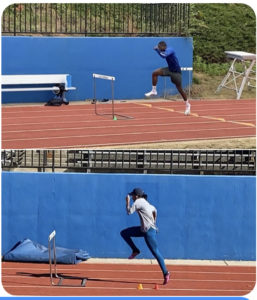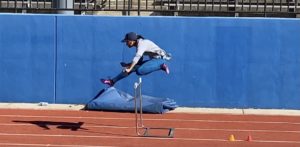Knee Up Heel Up
by Steve McGill
The first lesson I was taught when I first started hurdling was to “lead with the knee” of the lead leg. The logic was, and is, simple: If you’re leading with your knee, you have control and can drive forward. If you’re leading with your foot, you have no control and the leg will swing (up, or to either side). So I’ve always instructed my hurdlers to emphasize the knee drive when pushing off the back leg to attack the hurdle. But another equally essential element is what the heel of the lead leg foot does when the back leg pushes off. That’s what I want to discuss in this article.
[am4show not_have=’g5;’]
[/am4show][am4guest]
[/am4guest][am4show have=’g5;’]
One thing I’ve noticed is that in teaching sprint drills like A skips and B skips to their athletes, a lot of sprint coaches are okay with the heel swinging out in front a bit, but I think this action is a no-no for hurdlers, as it takes away space needed to clear the barrier. Hurdlers need to drive the heel up, under the hamstring, as they are driving the knee up. With the downhill style that I teach, we want the knee to be higher than the bar before the foot extends toward the crossbar. But we cannot get such knee height if the heel is not staying disciplined and driving up under the hamstring. I tell my hurdlers that they’ll feel a “squeeze” in the hamstring if they’re truly driving the heel up the way they’re supposed to. If they’re not feeling that sensation of the hamstring squeezing, then they’re really not leading with the knee in the truest sense, even if the knee is bent.
Recently I had two separate block start workouts with two of my better athletes — Malik Mixon, who lives about four hours away and comes up to train with me about once a month, and Falon Spearman, who is local and trains with me once a week. Because I’ve coached Falon off and on for several years now, and because she has mastered almost all of the elements that I teach, she has come to serve as a visual model of what I’m looking for. So when I was working with Malik, despite the fact that it was a very good session in which he looked very fast and aggressive, I could tell there was a piece of the puzzle that was missing. We were working on getting him to stop locking his knee when he extends his foot toward the crossbar, and he picked up on that very quickly. Yet there was still a piece missing. There was still something getting in the way of an uninhibited LET’S GO!!!!!! moment. When looking at the film later, I realized what it was: the heel. It was too low.

In this screenshot, which I sent in a text message to Malik, showing him the difference between himself and Falon, both of them are taking off into the hurdle. Both of them have a good forward lean from the waist going into the hurdle. Both of them have a tight lead arm action. Both of them are driving the knee of the lead leg at the crossbar. But look at the heels. Malik’s heel is low, and it’s positioned directly under his knee. Falon’s heel is higher, and it is positioned directly under her hamstring. So, Falon is really leading with the knee, whereas Malik is “kinda” leading with the knee.

In this next screenshot, you can see Falon and Malik at the moment their heel is passing over the crossbar. As you can see, Falon’s lead leg is at more of a downhill angle, while Malik’s is more at a horizontal angle. Falon’s downhill angle will enable her to accelerate off the hurdle effortlessly, whereas Malik’s flatter angle will require him to work a lot harder to just maintain speed off the hurdle, and he can forget about accelerating unless he really uses his upper body strength to push the speed between the hurdles. He’s capable of doing so, but as I’ve always said, the harder you have to work early in a race, the more prone you are to making mistakes later in the race.
Another point of comparison in the above screenshot would be in regards to where both knees are in relation to each other when the heel of the lead leg has passed the crossbar. I like to fantasize that the knees are directly beside each other, even though I know that’s impossible. But we want to get as close to that position as possible, because it means that everything is tight and that the back leg is coming right behind the front leg, with no delay and no pause. In looking at the screenshot, you can see that Falon’s knees are very close to each other, whereas Malik’s knees are very far apart from each other. This means more fluidity and ease of motion for Falon, as well as more speed off the hurdle. For Malik it means more work to clear the hurdle and therefore less ease of motion, leading to more effort required between the hurdles.

In this screenshot, Falon is descending off the hurdle. Here is where we want the leg to descend — on a downhill angle, not on a horizontal angle. This downhill angle is what will create speed off the hurdle. As I’ve said in previous articles, a “bent” lead leg over the hurdle doesn’t mean the leg doesn’t extend; it just means that it extends during descent, not on the front side of the crossbar. Falon was able to create this angle because her heel came up with her knee when she initially pushed off into the hurdle. Hence the phrase, “knee up heel up.”
So, all of this starts with dorsi-flexion of the ankles, let’s not forget. If the ankles aren’t dorsi-flexed and the toes are pointing up, nothing I’m talking about here in regards to what Falon is doing will work.
For someone like Malik, who has run 13.64 with a lead leg that locks at the knee and a heel that doesn’t drive up under the hamstring, there’s reason to believe he can get into the 13.20 range if he can make the necessary adjustments and master those movements.
[/am4show]
